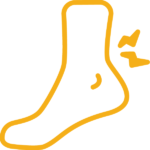SPORTS ACUPUNCTURE
What is Sports Acupuncture?
Anjuna Sports Acupuncture uses thin needles that are filiform and inserted into various areas on the body to induce positive therapeutic outcomes for high-performance athletes. The primary reason patients seek Sports Acupuncture therapy at our clinic is for pain management and rehabilitation.
Anjuna Sports Acupuncture significantly expands upon fundamental Traditional Chinese Medicine (TCM) approaches to the treatment of orthopedic conditions. Dr. Heide performs an orthopedic evaluation of musculoskeletal injury, understands the biomechanics of conditions, generates a TCM diagnosis, and implements a treatment plan.
This treatment approach applies TCM principles to Western biomedical diagnosis; uses biomedical facts to help explain TCM principles, thus fully integrating both medical paradigms. As a result, the assessment and treatment strategies become highly effective for high-performance athletes.
Typical Patients treated by Dr. Heide:
University of Oregon Duck Athletics Department Teams including Duck Football players, Duck Track and Field, Duck Baseball and Softball.
Professional Runners (Nike, Columbia)
Professional Skiers and Snowboarders (Burton, Rossignol)
Professional Rock Climbers (Five Ten, Evolv, LaSportiva)
Olympic Athletes (Track, Field, Marathon, Downhill Skiers)
NCAA Champions (UO Duck Football, UO Duck Track & Field)
Conditions Treated with Anjuna Sports Acupuncture
Dr. Heide holds advanced training certificates in DN-ET and Trigger Point Therapy. He performs an orthopedic evaluation of musculoskeletal injury, understands the biomechanics of conditions, and generates a working diagnosis with treatment approaches consistent with the patient’s referring physician notes.
Common Conditions treated include:
Muscle and tendon injury
ITB Syndrome
Hamstring Strain/Sprain
Ligament damage, including common sprains
Joint injury as well as chronic arthritis and inflammation
Acute and chronic low back and neck pain
Dysfunction of the musculoskeletal system
FOCUS AREAS
![]()
LEGS
Shin splints, both anterior and medial
Achilles tendonitis
Plantar fasciitis
Ankle sprain
“Big toe” (1st MTP joint) osteoarthritis
Morton’s neuroma
Pes anserinus inflammation
Metatarsalgia achilles bursitis
Fat pad syndrome
![]()
SHOULDERS
Muscle strain, tears, tendonitis, and inflammation usually respond well to acupuncture. Other injuries that benefit include bicepital tendonitis, frozen shoulder, and shoulder impingement syndrome. Dr. Heide has effectively treated the following shoulder conditions:
Supraspinatus and infraspinatus tendonitis
AC joint separation, AC joint arthritis
Bicepital tendonitis, biceps tendonosis
Levator scapulae syndrome
Stiff Neck
Shoulder impingement syndrome
Shoulder bursitis
Pectoralis muscle syndrome
Frozen shoulder
![]()
ARMS
Lateral epicondylitis (tennis elbow)
Medial epicondylitis (golfer’s elbow, climber’s elbow)
Carpal tunnel syndrome
Arthritis of the wrist, hand, and finger joints
![]()
HIPS AND PELVIS
Hip (trochanteric) bursitis
Osteoarthritis of the hip joint
Sacral-iliac joint dysfunction
Piriformis syndrome
The sacral-tuberous ligament
![]()
KNEES
Ligament sprain (MCL, LCL).
Patellar tendonitis
Patello-femoral joint pain, chondromalacia
Ilio-tibial band syndrome
BENEFITS OF SPORTS ACUPUNCTURE
SPORTS INJURIES
Sports Acupuncture enables treatment of chronic and acute sports related injuries and significantly reduces recovery time.
WEEKEND WARRIORS
Sports Acupuncture provides excellent recovery assistance for weekend warrior

HIGH PERFORMANCE
Sports Acupuncture helps deliver break-through healing for high performance, professional or collegiate athletes.
YOUNG ADULTS
Sports Acupuncture is a great option for young adults in high school sports who are injured and want to get back on the court.
What is dry needling?
Anjuna Medicine uses dry needling to stimulate the healing process of soft tissues to achieve pain relief and restoration of healthy physiology. Dr. Heide does this by inserting a thin filiform needle into distressed trigger points in the muscle to stimulate a muscle twitch, and ultimately, release. This technique is unparalleled at its ability to identify and eliminate neuromuscular dysfunction and pain. Research supports that dry needling improves pain, reduces muscle tension, and facilitates an accelerated return to active rehabilitation.
What is a “trigger point”?
A myofascial trigger point is a irritable point in a muscle that is associated with a hypersensitive nodule, or “knot”. This area can be stimulated to alleviate pain in a region that is painful for a patient.
What is the difference between acupuncture and dry needling?
Traditional acupuncture is based on the tenets of Traditional Chinese Medicine to align one’s chi, or energy. Dr. Heide expands upon these ideas with an understanding of anatomy and physiology, biomechanics and orthopedics to directly target and address specific points of pain with dry needling.
Does it hurt?
The needle used is very thin and most patients do not even feel it penetrate the skin. A healthy muscle feels very little discomfort with insertion of this needle, but if the muscle is sensitive with active trigger points within it, the subject will feel a sensation like a muscle cramp called the twitch response.
Are there any side effects to dry needling?
Side effects may vary among individuals. Mild muscle soreness or skin bruising are most common.
CONDITIONS TREATED
![]()
LOWER BACK AND NECK PAIN
Both the neck and low back are common patient complaints. Injuries include sprain, strain, bulging or herniated discs, and soft tissue injury. Due to the complexity of both the low back and the neck, we will treat only those patients that can be helped with acupuncture. Low back and neck pain must use an integrated approach, combined with complimentary modalities such as Chiropractic, PT, massage, and therapeutic exercises.
![]()
TENDONITIS
Commonly treated tendons include:
The Achilles tendon
Tennis elbow (inflammation of the extensor tendon of the forearm)
Climber’s elbow (inflammation of the forearm flexor tendons)
Shin splints–(tendinous inflammation to either the anterior or the medial compartment muscles)

ARTHRITIS AND JOINT CONDITIONS
Arthritis of the hip
Osteoarthritis of the 1st metatarsal-phalanges joint (the“big toe”)
AC joint arthritis and shoulder bursitis
Knee osteoarthritis (anterior, medial, or lateral compartments)
Arthritis of the smaller joints of the wrist, hand, and foot.

OTHER PAIN SYNDROMES
Anjuna Sports Acupuncture may be considered a very effective modality for treating other injuries and pain syndromes. Those who might benefit from different modalities are referred to the best practitioners in the Anjuna network and referral system.
